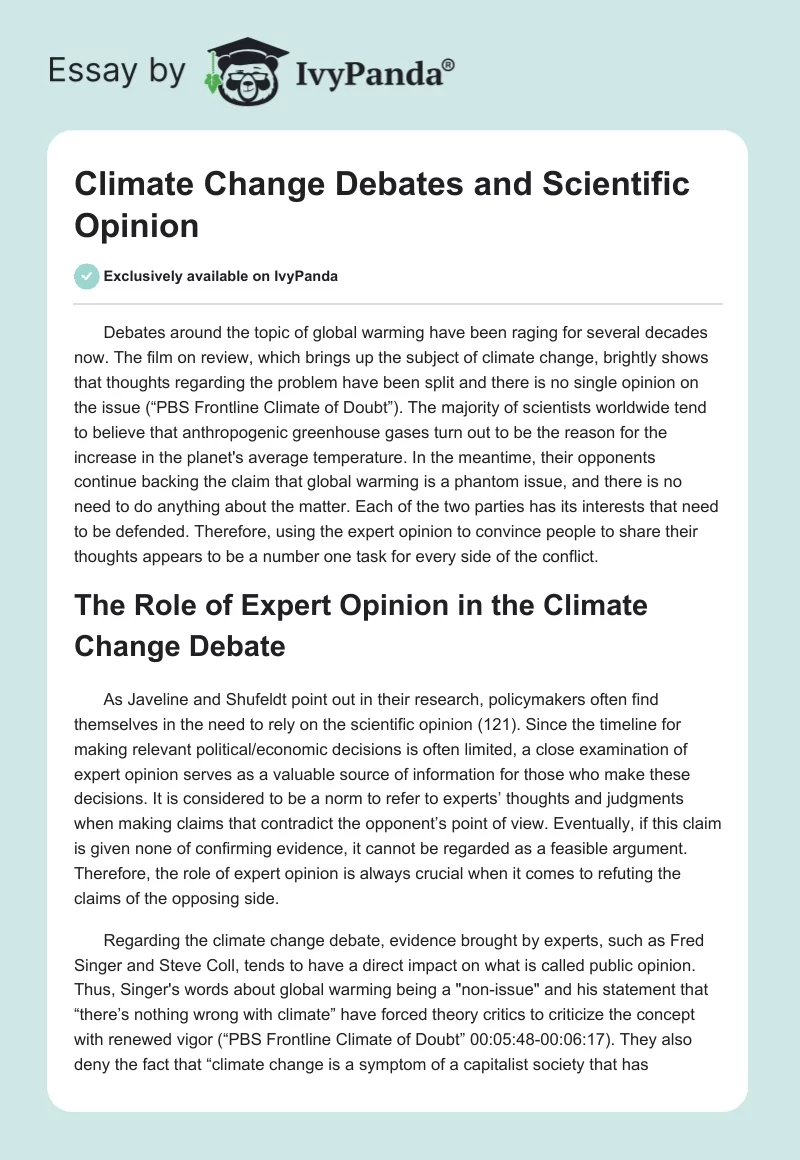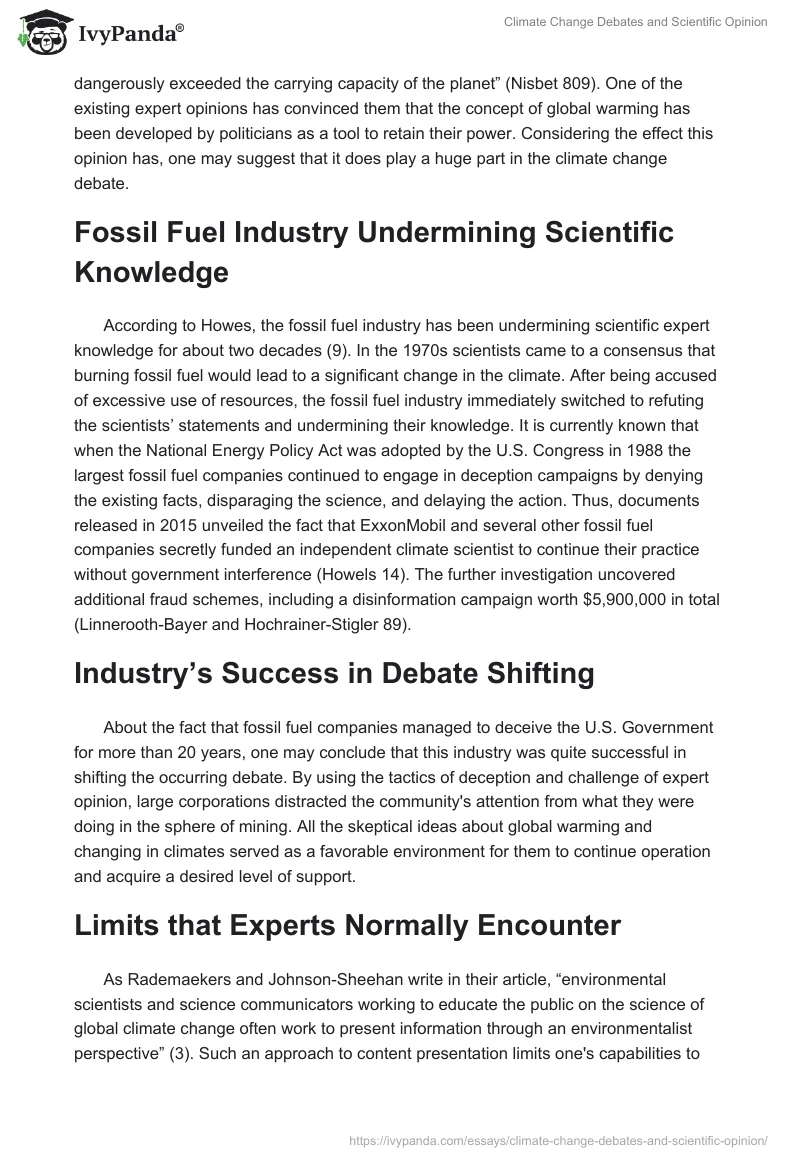Debates around the topic of global warming have been raging for several decades now. The film on review, which brings up the subject of climate change, brightly shows that thoughts regarding the problem have been split and there is no single opinion on the issue (“PBS Frontline Climate of Doubt”). The majority of scientists worldwide tend to believe that anthropogenic greenhouse gases turn out to be the reason for the increase in the planet’s average temperature. In the meantime, their opponents continue backing the claim that global warming is a phantom issue, and there is no need to do anything about the matter. Each of the two parties has its interests that need to be defended. Therefore, using the expert opinion to convince people to share their thoughts appears to be a number one task for every side of the conflict.
The Role of Expert Opinion in the Climate Change Debate
As Javeline and Shufeldt point out in their research, policymakers often find themselves in the need to rely on the scientific opinion (121). Since the timeline for making relevant political/economic decisions is often limited, a close examination of expert opinion serves as a valuable source of information for those who make these decisions. It is considered to be a norm to refer to experts’ thoughts and judgments when making claims that contradict the opponent’s point of view. Eventually, if this claim is given none of confirming evidence, it cannot be regarded as a feasible argument. Therefore, the role of expert opinion is always crucial when it comes to refuting the claims of the opposing side.
Regarding the climate change debate, evidence brought by experts, such as Fred Singer and Steve Coll, tends to have a direct impact on what is called public opinion. Thus, Singer’s words about global warming being a “non-issue” and his statement that “there’s nothing wrong with climate” have forced theory critics to criticize the concept with renewed vigor (“PBS Frontline Climate of Doubt” 00:05:48-00:06:17). They also deny the fact that “climate change is a symptom of a capitalist society that has dangerously exceeded the carrying capacity of the planet” (Nisbet 809). One of the existing expert opinions has convinced them that the concept of global warming has been developed by politicians as a tool to retain their power. Considering the effect this opinion has, one may suggest that it does play a huge part in the climate change debate.
Fossil Fuel Industry Undermining Scientific Knowledge
According to Howes, the fossil fuel industry has been undermining scientific expert knowledge for about two decades (9). In the 1970s scientists came to a consensus that burning fossil fuel would lead to a significant change in the climate. After being accused of excessive use of resources, the fossil fuel industry immediately switched to refuting the scientists’ statements and undermining their knowledge. It is currently known that when the National Energy Policy Act was adopted by the U.S. Congress in 1988 the largest fossil fuel companies continued to engage in deception campaigns by denying the existing facts, disparaging the science, and delaying the action. Thus, documents released in 2015 unveiled the fact that ExxonMobil and several other fossil fuel companies secretly funded an independent climate scientist to continue their practice without government interference (Howels 14). The further investigation uncovered additional fraud schemes, including a disinformation campaign worth $5,900,000 in total (Linnerooth-Bayer and Hochrainer-Stigler 89).
Industry’s Success in Debate Shifting
About the fact that fossil fuel companies managed to deceive the U.S. Government for more than 20 years, one may conclude that this industry was quite successful in shifting the occurring debate. By using the tactics of deception and challenge of expert opinion, large corporations distracted the community’s attention from what they were doing in the sphere of mining. All the skeptical ideas about global warming and changing in climates served as a favorable environment for them to continue operation and acquire a desired level of support.
Limits that Experts Normally Encounter
As Rademaekers and Johnson-Sheehan write in their article, “environmental scientists and science communicators working to educate the public on the science of global climate change often work to present information through an environmentalist perspective” (3). Such an approach to content presentation limits one’s capabilities to provide a versatile view of the topic. The absence of adapted material leads, in the end, to citizens’ reluctance to engage in debate. Also, the need to counter skeptics’ opinion creates challenges in what refers to convincing the audience about facts’ credibility.
Conclusion
In closing, one needs to admit that changes in climate and the need to stop global warming have been already discussed by governments for several decades. The arrival of critics and skeptics has formed a suitable background for doubts to occur. Inspired by the deceptive statements of the fossil fuel companies, people began believing that the increase in the Earth’s temperature was not a concern any longer. However, as seen from the film “PBS Frontline Climate of Doubt,” the temperature continues to rise, although showing some insufficient tendency to drop once in a decade.
Works Cited
“PBS Frontline Climate of Doubt.” YouTube, uploaded by Edward Grady, 2017, Web.
Howes, Michael. Politics and the Environment: Risk and the Role of Government and Industry. Routledge, 2013.
Javeline, Debra, and Gregory Shufeldt. “Scientific Opinion in Policymaking: The Case of Climate Change Adaptation.” Policy Sciences, vol. 47, no. 2, 2014, pp. 121-139.
Linnerooth-Bayer, Joanne, and Stefan Hochrainer-Stigler. “Financial Instruments for Disaster Risk Management and Climate Change Adaptation.” Climatic Change, vol. 133, no. 1, 2015, pp. 85-100.
Nisbet, Matthew C. “Disruptive Ideas: Public Intellectuals and Their Arguments for Action on Climate Change.” Wiley Interdisciplinary Reviews: Climate Change, vol. 5, no. 6, 2014, pp. 809-823.
Rademaekers, Justin King, and Richard Johnson-Sheehan. “Framing and Re-Framing in Environmental Science: Explaining Climate Change to the Public.” Journal of Technical Writing and Communication, vol. 44, no. 1, 2014, pp. 3-21.


